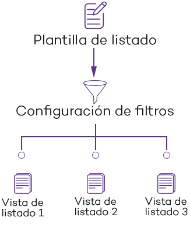Templates, settings, and views
A list consists of two items: a template and a filter.
A template can be thought of as a source of data about a specific area covered by Advanced EDR.
A filter is a specific configuration of the filter tools associated with each template.
A filter applied to a template results in a 'list view' or, simply, a 'list'. Administrators can create and save new lists for later consultation simply by editing the filters associated with a template, saving management time.

List templates
Click the Status menu at the top of the console. From the left panel, in the My lists section, click Add. A window opens with all available templates grouped by type:
| Group | List | Description |
|---|---|---|
|
General |
Licenses |
Shows details of the license status of the computers on your network. See Licenses module lists for more information. |
|
Unmanaged computers discovered |
Shows all Windows computers on your network that do not have the Advanced EDR software installed. See Unmanaged computers discovered list for more information. |
|
|
Computers with duplicate name |
Shows computers with the same name and belonging to the same domain. See Computers with duplicate namefor more information. |
|
|
Software |
Shows the software installed on the computers on your network. See Software for more information. |
|
|
Hardware |
Shows the hardware installed on the computers on your network. See Hardwarefor more information. |
|
|
Security |
Computer protection status |
Shows details of the protection status of the computers on your network. See Computer protection statusfor more information. |
|
Shows a list of the threats detected on the computers protected by Advanced EDR. See Malware/PUP activityfor more information. |
||
|
Shows the number of vulnerability exploit attacks suffered by the Windows computers on your network. See Exploit activityfor more information. |
||
|
Currently blocked programs being classified |
Shows a table with files which, although they have not finished being classified, Advanced EDR has initially detected represent a potential risk. See Malware/PUP activityfor more information. |
|
|
Blocks by advanced security policies |
Shows detected scripts and unknown programs that use advanced infection techniques. |
|
|
Blocks by advanced security policies |
Shows a list of the advanced threats detected on the computers protected by Advanced EDR. See Security module lists for more information. |
|
|
Detected IOCs |
Shows the indicators of compromise found on the customer’s computers. See Security module lists for more information. |
|
|
Indicators of attack (IOA) |
Shows confirmed indicators of advanced attacks on the network. See Indicators of attack (IOA). |
|
|
Patch management status |
Shows details of all computers on the network compatible with Cytomic Patch. See Patch management status for more information. |
|
|
Available patches |
Shows a list of all missing patches on the computers on your network and published by Cytomic. See Available patchesfor more information. |
|
|
Installation history |
Shows the patches that Advanced EDR tried to install and the computers that received them during the selected time period. See Installation historyfor more information. |
|
|
End-of-Life programs |
Shows information about the end of life of the programs installed on your network, grouped by the end-of-life date. See End-of-Life programsfor more information. |
|
|
Excluded patches |
Shows the computer-patch pairs excluded from installation tasks. See Excluded patchesfor more information. |
|
|
Activity control |
Programs blocked by the administrator |
Shows all attempts to run programs blocked by the administrator on the computers on your network. See Programs blocked by the administratorfor more information. |
|
Data protection |
Encryption status |
Shows information about the computers on your network compatible with the encryption feature. See Encryption statusfor more information. |
|
Cytomic Data Watch status |
Shows the status of the Cytomic Data Watch module included in Advanced EDR. See Cytomic Data Watch statusfor more information. |
|
|
Files with personal data |
Shows all PII files found on your network, along with their type, location, and other relevant information. See Files with personal datafor more information. |
|
|
Computers with personal data |
Shows the number of PII files found on each computer on your network. See Computers with personal datafor more information. |
|
|
Files deleted by the administrator |
Shows the status of the files deleted by the administrator using the Cytomic Data Watch module. See Files deleted by the administratorfor more information. |
|
Additionally, there are other templates you can directly access from the context menu of certain lists or from certain widgets on the dashboards. See the chapter dealing with the relevant widget.